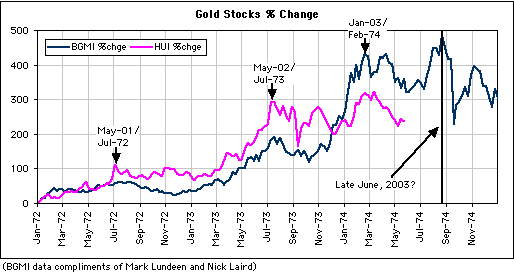
Back to the
70s / The Oil-Euro-Dollar Link
Here are extracts from commentary
posted at www.speculative-investor.com on 3rd April, 2003.
Back to
the 70s
Throughout the course of last year
we would occasionally show a chart comparing the progress of the Amex Gold
BUGS Index (HUI) since its November-2000 bottom with the progress of gold
stocks from their major bottom in January-1972 (using the Barrons Gold
Mining Index (BGMI) to represent the performance of the gold stocks during
the 1970s). Each time we showed the chart we marveled at how closely the
latest gold-stock bull market was tracking its 1970s' counterpart, although
we never took the chart too seriously because we could never come up with
a good explanation as to why the remarkable similarity should continue
into the future. In other words, we thought the chart comparison was interesting
and that it provided some confirmation that we were witnessing a major
bull market in gold stocks rather than just another bear market rally,
but we doubted that the chart had any predictive ability.
Below is an updated version of the
chart (the blue line on the chart shows the percentage change in the BGMI
from its 1972 bottom while the pink line shows the percentage change in
the HUI from its 2000 bottom). The chart continues to interest us because
although there have been large differences in the magnitudes of the moves
made by the BGMI during the 1970s and the HUI over the past few years,
the correlation between the two sets of data has remained high. Also, the
major turning points have continued to line up extremely well. For example,
the peaks in May of 2001, May of 2002 and January of 2003 occurred within
a few days of corresponding peaks in July of 1972, July of 1973 and February
of 1974. If the major turning points continue to coincide then gold stocks
should be bottoming now and there will be another important peak near the
end of June this year.

Our other work indicates that the correction
low is in place for the HUI. This means that the pattern is, at this stage,
unfolding as the above chart implies it should.
The Oil-Euro-Dollar
Link
A hot topic of late has been the idea
that the US invaded Iraq as part of a plan to dissuade OPEC countries from
deciding to price their oil in euros rather than US Dollars. The thinking
is that demand for the US$ gets a significant boost from the fact that
oil is traded in US Dollars and that if other OPEC nations followed Iraq's
lead and decided to sell their oil in euros, the relative value of the
US$ would fall. This would, in turn, create economic problems for the US.
The above-described idea is interesting,
but in our view makes no sense. If the OPEC countries, or any oil-exporting
countries for that matter, decided that they were accumulating too many
US Dollars and that they would prefer some other currency, they could simply
sell their dollars in the foreign exchange market. In fact, this is exactly
what Mexico is doing right now with the 'surplus' dollars accumulated via
oil sales. As far as the relative values of the US$ and the euro are concerned
there is no difference between a) selling the oil for dollars and then
exchanging the dollars for euros in the currency market, or b) selling
the oil in euros in the first place. In other words, if the OPEC countries
desired more euros and less dollars they could be acting on that desire
right now.
Further to the above, the US Dollar's
relative value is not determined by the currency in which oil is priced,
but by the desire of foreign investors to hold dollars or investments
denominated in dollars. And this desire to hold dollars is, in turn, determined
by the expected return on dollar-denominated investments relative
to the expected return on investments denominated in other currencies.
Therefore, if you believe (as we do) that the returns on dollar-denominated
investments over the next year or more will be insufficient to entice the
massive capital in-flows needed to offset the huge US current account out-flows,
you should be bearish on the US$. We are very bearish on the US$ beyond
the next 1-2 months.
So much misinformation is dispersed
by governments and the news media on a daily basis in an attempt to prevent
us from seeing things as they really are that it makes no sense to blindly
accept the official, or widely publicised, explanations for anything. Therefore
when George Bush and Tony Blair state their reasons for invading Iraq,
reasonable people are naturally suspicious. In this case, though, it is
entirely possible that the openly-stated motive for invading Iraq (genuine
security concerns) is the real motive. While it is certainly arguable as
to whether such concerns are justified and, even so, whether invading Iraq
is the right course of action to address these concerns, why search for
an ulterior motive when the openly-stated motive makes the most sense?
Regular financial market forecasts
and
analyses are provided at our web site:
http://www.speculative-investor.com/new/index.html
One-month free trial available.

|

